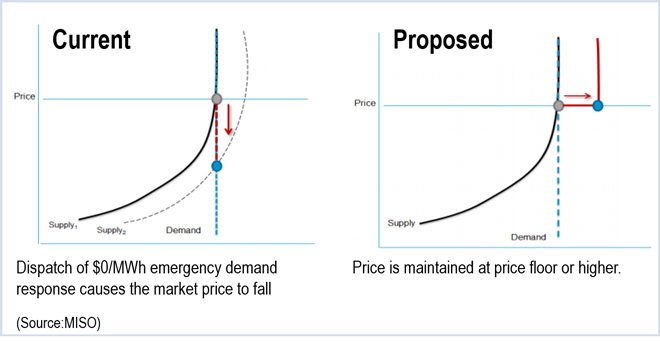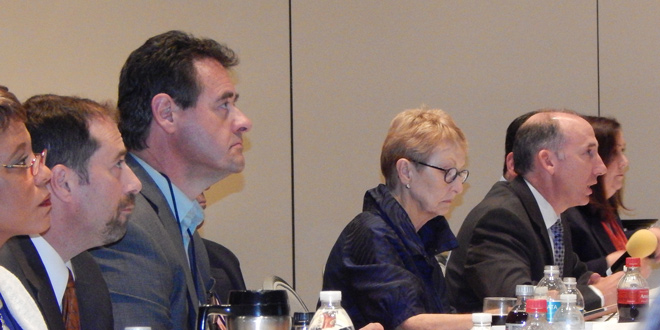By Rich Heidorn Jr.
ATLANTIC CITY, N.J. — PJM officials and the Independent Market Monitor are considering changes to the treatment of virtual transactions to reduce uplift and gaming opportunities and allow quicker solving of the day-ahead energy market.
PJM Executive Vice President for Operations Mike Kormos and Market Monitor Joe Bowring floated ideas for potential changes during a Year in Review presentation at the PJM Annual Meeting at the Borgata Hotel Casino last week.

Bowring suggested PJM consider NYISO’s model, which limits virtual transactions to zones or hubs. Kormos said the RTO could consider either removing the financial transactions from the day-ahead market or making the day-ahead a pure financial market.
In interviews afterward, Bowring and PJM officials said the changes could address uplift and allow quicker solving of the day-ahead market to reduce the disconnect with gas trading schedules.
NY Model
Bowring made his suggestion first, saying PJM might benefit from adopting NYISO’s treatment of virtual transactions — increment offers (INCs), decrement bids (DECs) and up-to-congestion transactions. “Should that be a secondary derivative market or in the PJM market?” he asked.
He said virtual transactions were introduced into the market to improve efficiency. “I think we’ve gone well past that now,” he said, saying they affect unit dispatch and commitments and cause congestion. “I haven’t come to a full and final opinion on this, but questions need to be asked,” he added.
Bowring said his primary motivation for wanting to change the treatment of virtual transactions is to reduce gaming opportunities. “The ability to manipulate the market … would be substantially reduced by limiting financial transactions to zones and hubs or putting them all in a secondary market where they do not affect the actual operation of the market,” he said.
Executive Vice President for Markets Andy Ott said Bowring’s suggestion is “something we need to look at.”

Ott said large volumes of virtual trades are “dumped into the market” because there’s no cost for doing so. Although most do not clear, the large volumes slow processing time for the RTO’s security constrained economic dispatch.
Kormos made his suggestion in response to questions after Bowring’s presentation. “It’s the blending of the physical and the financial that’s causing the uplift” and making the market more difficult to solve, he said.
If the day-ahead market became purely financial, the reliability assessment and commitment (RAC) run could determine the day–ahead schedules for generators, said Mike Bryson, executive director of system operations.
Eliminating physical generation from the day-ahead market could aid efforts to post day-ahead results sooner, Kormos said. A market with no generator minimum run times “would solve a lot faster,” he said.
Under the current system, Bryson said, virtual trades can hurt reliability by masking transmission congestion.
An increment offer — an offer to sell to the day-ahead market if prices go above a specified price — can act like a dispatchable resource. But transmission constraints that are “solved” financially by virtual trades remain in the physical market, Bryson said. “In real time there wasn’t truly a generator there.”
Any changes would be subject to stakeholder review to determine their impacts. For example, limiting virtual transactions to only zones and hubs would prevent them from using generation buses, reducing their value as hedges for generation.
Gas-Electric Scheduling
Ott said PJM hopes to reduce the day-ahead market solution to three hours from the current four-hour average in time for the Federal Energy Regulatory Commission’s April 1, 2016, deadline for changes to gas-electric scheduling. (See PJM Considering Change to Day-Ahead Deadlines in Response to FERC Gas Schedule Order.)
PJM officials are considering parallel processing and sequencing changes to speed the market solution. Ott said further reductions would not be “feasible” in the next year.
Bowring said the 85% reduction in UTC trading since FERC suggested the transactions might be subject to uplift charges had contributed to a recent reduction in the processing time required for the day-ahead market. (See FERC Issues Request for Comments in UTC Uplift Docket; Ruling by October.)
Ott demurred. “Before we jump to conclusions, we have to see what is the cause of the day-ahead market running faster,” he said.
PJM currently posts its day-ahead results at 4 p.m. The time required to solve varies from day to day depending on factors such as transmission outages and load projections. Most days it takes three to three and a half hours. But some days can take more than four hours, according to a PJM analysis that will be presented at Thursday’s Markets and Reliability Committee meeting.
“Some days you’re bringing it all [generation] on or you’re hardly bringing anything on,” and solution is easier, Kormos said.
Ideally, Kormos said, PJM would like to post its results by 1 p.m. ET, an hour before the first gas nomination deadline at 2 p.m.
Members Polled
PJM is compiling the results of a poll that closed May 18 to gauge members’ preferred response to the FERC order.
The poll asked members which day-ahead market start time would allow them adequate time to construct their offers, with choices ranging from 9:30 a.m. to 11 a.m. It also asked preferences on posting times to provide sufficient time to purchase fuel, offering choices between 1 p.m. and 2 p.m.
Because FERC declined to change the start of the gas day, however, RTO officials say there is no escaping some uncertainty. Other RTOs are wrestling with the same dilemma. (See SPP Trying to ‘Balance the Risk’ on Gas-Electric Schedules.)
“In [either the gas or electric] markets you have to commit before you have your numbers locked up,” Kormos explained.
















